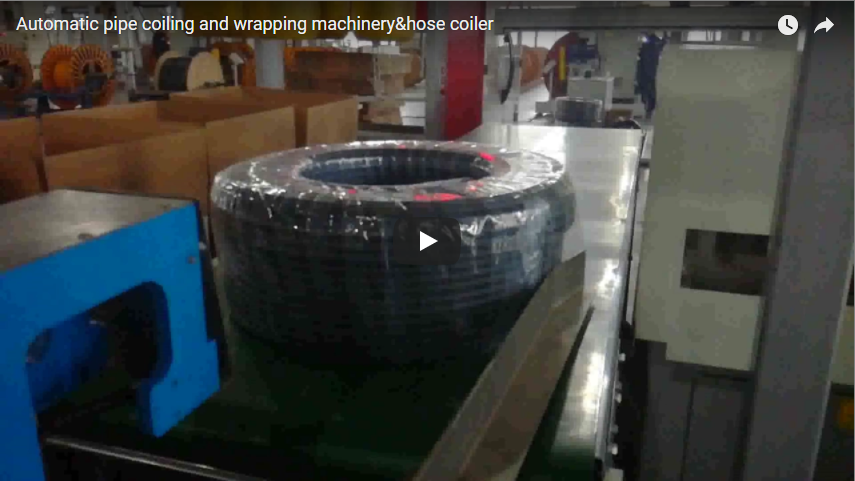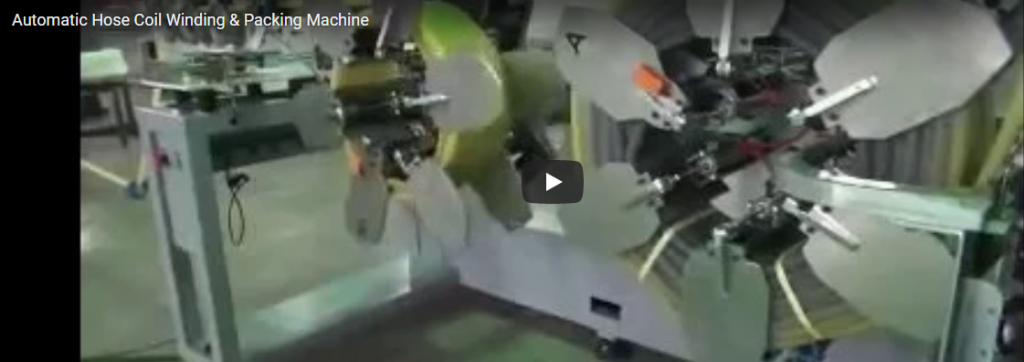Streamlining Production: A Closer Look at the FHOPE Automatic Pipe and Hose Coiling & Strapping Machine
Manual coiling and strapping of pipes and hoses – a time-consuming bottleneck prone to inconsistencies and ergonomic risks – is a familiar challenge in many manufacturing and fabrication environments. Addressing this critical need, FHOPE PACKAGING offers an integrated solution: the automatic pipe coiler and hose coiling machine equipped with Polypropylene (PP) strapping capabilities. This system is engineered to significantly enhance efficiency, consistency, and safety in packaging operations for extruded products.
Let's see this machine in action:
This machine isn't just about replacing manual labor; it's about upgrading the entire post-extrusion handling process. Whether you're dealing with flexible conduit, PEX tubing, hydraulic hose, or garden hose, achieving a tightly wound, securely strapped coil ready for storage or shipment is paramount.
1. Core Functionality: Beyond Simple Winding
At its heart, the FHOPE machine automates two critical tasks:
- Precision Coiling: It takes extruded pipe or hose directly from the line (or offline) and winds it into neat, uniform coils based on pre-set parameters like coil diameter and length. Crucially, many models incorporate a traversing unit that guides the material back and forth, ensuring a level, stable wind – essential for package integrity and downstream handling.
- Automated PP Strapping: Once the desired coil length is reached, the machine automatically positions the coil, applies PP straps at designated points, tensions them securely, seals them (typically via heat or friction weld), and cuts the strap. This eliminates manual handling and ensures consistent strap placement and tension.
2. Technical Deep Dive: Understanding the Capabilities
While specific configurations vary based on application needs, typical operational parameters often include:
- Material Handling:
- Pipe/Hose Diameter Range: Typically from a few millimeters up to 50mm or more, depending on the model.
- Compatible Materials: PE, PEX, PVC, ABS, Nylon, Rubber, reinforced hoses, corrugated conduit, etc.
- Coiling Specifications:
- Coil Outer Diameter (OD): Adjustable, often ranging from 300mm to 1200mm+.
- Coil Inner Diameter (ID): Adjustable, linked to the coiling drum size.
- Coil Width (Traverse): Adjustable to accommodate different coil sizes, e.g., 50mm to 500mm.
- Max Coil Weight: Dependent on machine size and construction, potentially up to 100kg or more.
- Operational Parameters:
- Coiling Speed: Variable, often synchronized with extruder line speed, capable of handling significant production rates (e.g., up to 60 meters/minute or higher).
- Strapping Type: Polypropylene (PP) strapping is standard due to its balance of cost, strength, and flexibility.
- Strap Width/Thickness: Accommodates common PP strap sizes (e.g., 9mm, 12mm, 15.5mm width; 0.5mm - 0.9mm thickness).
- Number of Straps: Programmable (e.g., 2, 3, or 4 straps per coil).
- Control System:
- Typically PLC controlled with an HMI (Human Machine Interface) touchscreen for easy parameter setting, recipe storage, and diagnostics.
(Note: These are representative parameters. FHOPE customizes machines to specific client requirements.)
3. The Operational Workflow: From Extrusion to Packaged Coil
Observing the machine highlights a seamless process:
- Infeed & Measurement: Pipe or hose feeds into the coiler, often passing through a length counter or synchronized with line speed data.
- Coiling Commencement: The leading end is secured to the coiling drum/mandrel.
- Winding & Traversing: The drum rotates, pulling the material. Simultaneously, the traversing unit guides the pipe/hose side-to-side, building a level coil.
- Length Achievement & Cutting (Optional): Once the preset length is reached, the line may pause briefly for an integrated cutter (if equipped) or signal an upstream cutter.
- Coil Transfer & Strapping: The coiling drum often collapses slightly or retracts, allowing the completed coil to be automatically moved or positioned into the strapping station.
- Strapping Cycle: The strapping head(s) engage, feed strap around the coil, tension, seal, and cut the strap at programmed locations.
- Ejection: The finished, strapped coil is automatically ejected onto a conveyor, accumulation table, or palletizing system.
4. Key Advantages & ROI: Why Fabricators Invest
From personal experience observing these systems in various plants, the benefits are tangible and go beyond simple automation:
- Dramatically Increased Throughput: The speed and continuous operation far surpass manual capabilities, directly boosting output.
- Consistent Package Quality: Every coil is wound to the same dimensions and strapped with the same tension and placement, enhancing product presentation and stackability.
- Significant Labor Savings: Operators previously dedicated to monotonous coiling and strapping can be redeployed to higher-value tasks. Payback periods based on labor savings alone can be surprisingly short.
- Improved Workplace Safety: Automating the handling of potentially heavy or awkward coils reduces risks of strains, repetitive motion injuries, and contact with moving machinery.
- Reduced Material Waste: Optimized strap usage and elimination of inconsistent manual strapping minimizes PP strap consumption.
- Enhanced Professionalism: Uniform, securely packaged products project a higher level of quality control to the end customer.
5. Customization and Integration: Tailoring to Your Line
One size rarely fits all in manufacturing. FHOPE emphasizes the customizable nature of these machines. Options often include:
- Size & Capacity Variations: Matching the machine to your specific product dimensions and weight.
- Number of Strapping Heads: Configuring for the required number and position of straps.
- Integration Features: Designing interfaces for seamless communication with extruders, cutters, pullers, conveyors, and downstream palletizing or wrapping equipment.
- Semi-Automatic Options: For lower volume applications or where more operator interaction is desired.
- Safety Guarding: Tailored safety fencing, light curtains, and interlocks meeting regional standards.
6. Application Focus: Where This Technology Shines
In my view, these automatic coiling and strapping systems deliver maximum impact in environments producing high volumes of flexible materials. Industries like:
- Wire & Cable: Though often requiring specialized payoffs/takeups, the coiling/strapping principle applies.
- Plumbing & Construction: Handling PEX, PE-RT, corrugated drainage pipe, and conduit.
- Automotive: Manufacturing fuel lines, air brake hoses, and convoluted tubing.
- Agriculture: Producing irrigation tubing and durable hoses.
- General Industry: Any application involving continuous lengths of flexible pipe or hose requiring coiling for shipment or storage.
The ability to integrate this machine directly downstream from an extrusion line creates a truly automated "extrude-to-package" workflow, minimizing handling and buffer requirements.
Conclusion: A Strategic Investment in Efficiency
The FHOPE automatic pipe coiler and hose coiling strapping machine represents more than just automation; it's a strategic investment in operational efficiency, product quality, and worker safety. By tackling the labor-intensive and often inconsistent manual processes, it allows manufacturers and fabricators to increase throughput, reduce operational costs, and deliver a more professional, securely packaged product to their customers. For companies handling significant volumes of pipes and hoses, evaluating this technology is a crucial step towards optimizing their packaging operations.
For more detailed specifications or to discuss your specific application:
https://www.fhopepack.com/Automatic-Coiling-Machine/
info@fhopepack.com






